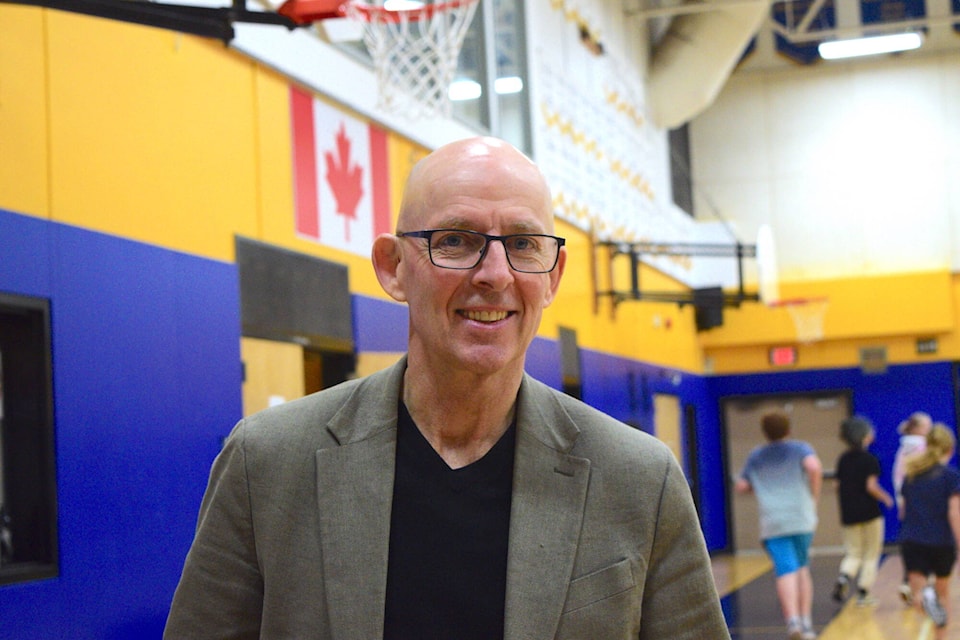Matthew Monkman started teaching in 1987 when he received his first teaching job in Houston. He chose Houston because his parents were both educators in the school district. In 2019, he assumed the role of Assistant Superintendent.
For the majority of his almost four-decade career at SD54, Matthew was known as the “tech guy.”
He worked in Houston as a Grade 7 teacher, then a teacher librarian, then a vice principal, before accepting a job as a district computer teacher. He later went on to become the district principal of Technology and Innovation.
“Lots of years teaching people how to use computers, going around doing sessions with students on ‘what is this thing called the internet?’ and protecting your privacy on the web in those early, early days,” said Matthew.
To this day, people in the community still approach him and recognize him for the knowledge he imparted during those early internet days.
“The most important part of education is to nurture our young people to be critical consumers of the world around them,” explained Matthew. “With the onset of AI (artificial intelligence), truth can be anything you want it to be.”
Matthew remains conscious of changing digital landscapes and is mindful of adapting the education system as the world transitions deeper into the realm of AI.
“If you’re assessing your ability to write something that’s articulate, it’s got the nice flow and all the rest of it, then I’m gonna have to give you a different tool than an electronic online tool to demonstrate that to me. So here’s the pad of paper and a pen,” explained Matthew.
“But if I’m looking to assess something else, wanting to know your knowledge about a certain topic, you can give me a little video report on that,” explained Matthew.
Ten years ago, before he became assistant superintendent, Matthew worked with the distributed learning school to develop online courses. What started as a program from homeschooling families, eventually laid the foundation for virtual learning during the pandemic.
“When COVID hit here, it wasn’t much of a pivot for many folks,” he explained.
Change and innovation, are guiding principles for Matthew’s approach to the education sector.
When he was studying at the University of Victoria, for his Bachelor of Education degree, then later for his Masters of Education Administration, he would ride his bike to the Royal BC Museum. He enjoyed the installments but felt Indigenous perspectives were missing from the exhibits.
“The way I grew up, it was a page in the history book,” explained Matthew. “Indigenous people were seen as being a backward culture.”
Having spent 36 years in the B.C. education system, Matthew has observed progressive shifts to make the SD54 school district a more inclusive environment.
“When I started my teaching career, there was no Indigenous presence in the schools and SD54, but through great work done by some amazing people in this district, the residential schools unit has been taught for over a decade,” said Matthew.
One reason Matthew strives to make the world a more inclusive place is for his wife Teresa, a former pageant queen, who was crowned Miss Smithers in 1981 and worked in the school district with Matthew.
“I married an absolute angel on Earth who has helped me to be a better person,” said Matthew.
They both worked with the school district to develop a set of five guiding values: Habi ghë dzï Ts’il Ts’ ïtl (compassion), Tsë’un hol’iy (honesty), Wiggus (respect), Wighin lïnï (responsibility) and Tsë’un (fairness).
Matthew says these themes are present in the new SOGI curriculum, a curriculum that’s being introduced throughout B.C. to educate young people on sexual orientation and gender identity.
“The intent of the SOGI curriculum is to create safe places within our schools and then by extension, once children are educated, throughout our communities,” said Matthew.
”It is simply about creating safe places for everyone, to me that means going back to those five words.”
Another significant shift toward inclusivity Matthew observed throughout his time as an educator, was the design of SD54’s logo.
“There’s a whole story behind that,” he said.
The first year he stepped into his current role, one of the trustees suggested the logo be changed to highlight Indigenous culture.
The old logo looked similar to the current one, which is the number ‘54’ traced by an eagle feather. The previous logo was ‘54’ next to a quill feather, a “very colonial symbol,” he said.
“We engaged with a Witsuwit’en artist who resides in Vancouver, Jolene Andrews, and she came up with that gorgeous feather on top.”
Matthew’s dedication to decolonizing the education system is receiving recognition across the North.
After committing to retiring from SD54, Matthew was offered an interim role with Nisga’a nation as a Superintendent.
He saw this offer as a “calling,” so decided to delay his retirement plans for a while and signed a one-year contract.
“It is an incredibly unique environment,” explained Matthew. “The Nisga’a Nation negotiated the only modern treaty in British Columbia.
“Their land is not a reserve, you’re not doing a land acknowledgment there. Because it is not unceded territory, it’s just Nisga’a Nation and so they have their own government.”
Matthew’s biggest concern regarding his departure from SD54, is who will be willing to open up the gym after hours. Every Sunday, Matthew opens up the Smithers Secondary School gym to allow kids to come in and use the facilities.
The initiative is called “Open Gym,” but kids refer to it informally as “Monkman Gym.”
In Matthew’s opinion, one of the most important skills you can develop is “physical literacy,” learning to understand your own body and ensuring that you keep moving throughout your lifetime.
